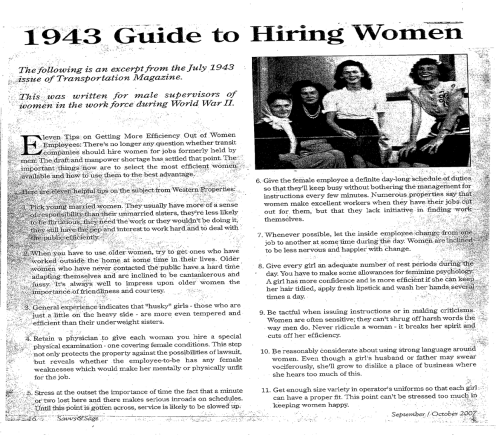The concept of ‘teleworking’ is emerging in the world of work as a flexible form of employment which can provide many benefits to employers and employees. It has been seen to provide benefits to workers through offering employment options for those who may normally become excluded from the labour market, in addition to an enhancement of job satisfaction. Moreover, employers also reap the benefits of teleworking, with financial savings made possible by means of a reduction in overhead costs and necessitation for office space, an amplification of the labour pool and a noticeable decrease in absenteeism levels. However, there are also some notable disadvantages of teleworking which include matters concerning a lack of social and group interaction for teleworkers, and the pressure to ensure productivity levels are consistently high compared with others in the workplace. Employers may also encounter problems tracking precisely what the employee is completing, and ensuring that functions such as remuneration and rewards are appropriately allocated.
There is a high level of ambiguity associated with the term ‘teleworking’ as the concept remains difficult to define. This may be attributed to the use of tantamount terminology used interchangeably including ‘telecommuting’, ‘homeworking’ and ‘teleworking’. Telecommuting initially emerged as a means of preventing the daily travel to an individual’s place of employment. The first telecommuter on record was in 1977 when a Boston bank president installed a phone line between the bank and his home (Blackwell, C.W. 2002). In 1973 Jack Nilles, a rocket scientist working on a NASA satellite communications project moved his work home in order to avoid the Los Angeles gridlock. Consequently he felt relaxed, with fewer interruptions and experienced noticeably higher productivity levels (Buttross et al. 2002). Thus this notion reinforces the idea that work is an activity that is performed rather than simply a location to go to.
Comparably homeworking places immense importance on the location work is performed, namely the home environment. However there are a few aspects which must be evident in order to distinguish teleworking from other forms of decentralised work performed at home; telework should constitute work which is partially or fully independent from the location of the employer, utilise Information Technology (IT) including computers, telephones and the internet, and be delivered through an organisational form with some type of communicative link to the organisation (Baruch, Y. 2000). Thus, teleworking may be defined as a flexible way of working which enables workers to get access to their labour activities from different locations by the use of Information and Communication Technologies (Perez Perez et al. 2003).

One of the main benefits of Teleworking for employees is the elasticity of the job structure. Workers who are unable to adhere to rigid 9-5 employment in a city location are given the opportunity to complete their job and remain in employment. This may include individuals who have to relocate, are unable to work full-time hours and those with family responsibilities and/or maternity leave. Patrickson’s (2002, pp. 704-715) article articulates that firms may even utilise this widening of the labour pool to include conventionally disadvantaged groups as a method in which to enhance the corporate image as being socially responsible. For instance, teleworking may be an opportunity for disabled or older workers. Evidently this is also a positive for employers who are then able to project a socially conscious image to the public, and/or retain quality, skilled and trained staff from leaving the workplace.
Furthermore with the eradication of travel time, employees no longer endure fatigue, strain and irritation associated with physical travel, have more leisure time and have higher productivity levels due to a minimization of distractions normally occurring in the workplace (Fairweather, B.N. 1999). This is supported by a European Union-backed survey wherein more than 90 per cent of teleworkers for British Telecoms reported benefits such as lack of commuting, higher productivity, increased leisure time, the capacity to multi-task and the independence to choose when to work. Moreover, the flexibility reportedly allows workers to perform whenever it makes sense to the individual such as peak personal times (for instance early in the morning or late at night) which leads to a greater overall control over one’s own time (Colihan et al. 1998). The social impact of this teleworking arrangement has led to 69 percent of AT & T workers to state that they are more satisfied with their job (Hrisak, D.M. 1999). Additionally, motivation may be improved as employees respond positively to the trust and confidence their employers have illustrated (Clay et al. 2001). Thus it may be conceded that the benefits of teleworking may lead to overall increased levels of job satisfaction, personal effectiveness and employee engagement.
Further to this, without the flexibility of teleworking many employees would be imputing less effort and commitment to the workplace, manifesting as high absenteeism levels and even attrition rates. The impacts of predicaments or problems which result in employee becoming absent from work such as weather, transport, illness or injury is significantly reduced with the nature of teleworking (Clay et al. 2001). The 1999 Telework America National Survey reports that 30 per cent of teleworkers would take personal leave, 17 percent would take sick leave and 14 per cent would leave work early to manager their personal needs if they were unable to telework. Thus, teleworking permits a degree of flexibility for an employee which ultimately allows workers to maintain personal needs whilst remaining committed to the job.
However the driving force behind many employers’ decisions to implement teleworking is arguably cost minimization for the organisation. Nilles (1994) affirms that with the costs of traditional office space skyrocketing in recent times, and transferable telecommunication equipment plunging, the expenditure of outfitting a teleworker may be possible to recover in less than a year. The reduction in real estate required is most definitely a major benefit (Blackwell et al. 2002). Additionally in contemporary society, many organisations are forced to consider the impact that the political world creates on the organisation. For instance, after the collapse of the World Trade Centre, the attack known as “9/11”, many are reluctant to place all their resources in one location (Blackwell et al. 2002). Subsequently, teleworking allows a company to have many human resources working from various locations. Thus there are significant savings to be made through the reduction in overhead costs and office space, in addition to the benefit of securing human resources at various locations.
Despite the apparent benefits previously mentioned, there are also the potential disadvantages that must be considered. Employers must contemplate the change in environmental factors which may alter the way work is performed. One of the most prominent concerns is the issue of isolation and lack of interpersonal interaction which is normative in many workplaces. This may include informal chats around the water cooler, grapevine communication, meetings and social outings. In a common teleworking situation, this is abruptly replaced with an individual sitting on their own using emails, faxes and telephone calls to communicate rather than face-to-face contact. As a result, some of the most common disadvantages as outlined by Shabha and Ward (1999) include the inability to bounce ideas and problems off co-workers and others in the workplace, a complete lack of social interaction, feelings of isolation from developments concerning their career and the company, and finally a diminishing sense of belonging to the company which subsequently impacts on the individuals commitment. This may also have a detrimental effect on productivity, creativity, innovation and overall effectiveness (Diamond et al. 2002), with one third of employees surveyed at BC Drinks Ltd asserting that teleworking had increased rather than decreased their stress levels (Harris, L. 2003). This evidence suggests that not every individual has the capacity to telework due to the lack of social interaction, which has serious implications for recruitment and selection of those who telework within an organisation.
Previously the benefits associated with increased control over one’s time were mentioned, in addition to the flexibility to perform work when it is most optimal for the individual. Despite this autonomy, there is evidence to suggest that teleworkers have a tendency to work outside normal working hours with the underlying expectation from management that supplementary hours would be worked (Diamond et al. 2002). Thus, teleworkers feel pressured to work harder to get the tasks done, with many discovering they have increased workloads, due to a lack of support available to those in the workplace such as administrative assistants and managers for instance. A whopping 85 per cent of those surveyed at BC Drinks Ltd reported a longer working day with another 60 percent stating that working weekends to ‘catch up’ was a regular practice (Harris, L. 2003). Therefore, telework as a form of employment may be disadvantageous due to underlying pressures inducing employees to work longer and harder, leading to increased stress levels and a decreased level of potential with the organisation.
Likewise, teleworking has also contributed to the blurring of the division between work and leisure time. Many organisations implement teleworking strategies in the belief that they are promoting the balance between work and family, however in many instances this is not the case. Despite the flexibility of being able to drop children off at school, and work around other commitments in one’s life, teleworkers may also find that the realms of work and family have been blurred to the point that they have become indistinguishable from one another. Tietze (2002) identifies coping strategies such as ‘separators’ which involves adhering to strict regimes in order to keep work and family detached, and ‘integrators’ which follows a more laissez-faire temporal regime to integrate domestic and professional activities. For example, in order to separate work and family a teleworker may establish a closed door area to work in complete with a dress code for the hours of ‘work’. Despite these coping strategies, the teleworker must remain pragmatic about the situation. The time spent at home will take on a new meaning when the realm of work invades this private domain, and the fact that children do not have the capacity to divide between work and play must be considered (Kleiner, B.H., and Tan-Solano, M. 2001). Thus the work and family balance is a responsibility the teleworker must be prepared to manage.
Moreover, the increased autonomy of teleworkers ensures that many of the HRM functions including remuneration, rewards and recognition, remains an intricate process. With this new form of work; the phenomenon that is teleworking, many employers feel that it is difficult to compensate someone who is not under their direct, physical control. In order to overcome this, organisations must learn precisely how to measure real productivity, rather than merely calculating hours spent in the office (Davidson, K. 1992). With this there is also a requirement for companies to learn how to effectively manage the workers who telework, as the standard policies and practices are simply not adequate. For instance, a survey of telecommuting practices in Canada exposed that only 25 per cent of telecommuting organisations had a specific human resource policies directed at their telecommuters (Solomon, N.A., and Templer, A.J. 1993). Also consider the issues of rewards, recognition and promotion. A major concern for teleworkers has been the issue of promotions and recognition, with many fearing that because they were ‘out of sight’ that they would also be ‘out of mind’. Thus this highlights the importance of a performance management system which specifically measures those on productivity and achievements, rather than physical, tangible presence in the office.
So what do you think? I know it was long and you felt like you were marking a paper reading it, but this has reminded me of so many reasons for and against working from home. It’s also important to remember that not everyone has the ability to do this and we need to determine who these people are.
As HR, do we have all our ducks in a row on this one? Are the correct policies and support services in place?


